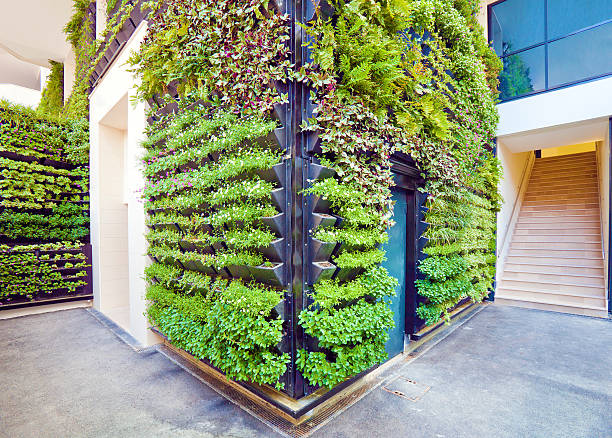Vertical succulent gardens are wonderful things and if you have ever planted one, you’ll know just how fantastic they can look, and just how hard they can be to water effectively. Watering frequency is tricky to get right with plants at the best of times, and a vertical setup can be even harder to handle.
Some of the best ways to ensure that you can water your plants effectively include making sure that your succulents have similar watering needs, watering regularly and depending on the season, and giving your succulents time to develop strong roots before hanging the vertical planter up.
What Are The Challenges Of Watering A Vertical Succulent Garden?
There are a few reasons that it can be hard to water your succulent garden properly, and one of the biggest is that different plants like different amounts of water. If your succulent plants all prefer different conditions, it will be extremely difficult or impossible to please them.
Deep planters can also be problematic when it comes to vertical gardens, because the soil is much more likely to shift and sink when watered. When you wet the soil, you take the air out of it and make it heavier, which often makes it sink in the planter.
This disrupts the roots of your succulents and may also ruin your planter, depending on how severe the sinking is. It is not a good idea to use deep planters for your vertical succulent garden.
You may also find that once your planter is vertical, your succulents try to fall out when you water them. Again, this is because watering loosens and shifts the soil, which is what is holding them in place. The soil is the only anchor that the roots have, so if you move it, plants – particularly heavier plants – are likely to come free.
How Should I Water My Succulent Garden?
Tip One: Set It Up Carefully
While this isn’t quite an aspect of watering it, the setup is crucial to consider. You need to think about both your plants and the kind of container that you are adding them to.
It is important to choose containers that are reasonably shallow so there isn’t much soil weight to deal with. This will help to keep your plants a reasonable size, too, as their roots will be somewhat more cramped and they won’t grow as quickly.
The right container can make a big difference to watering. You don’t want one that is so deep you can’t properly saturate the soil, or one that leaves large quantities of sodden soil around your plant’s roots.
Your container should hold enough moisture to keep your plants damp for a few days, but should not be deep enough that your succulents are at risk of root rot. Ideally, you need a few inches and no more, depending on the kinds of succulents that you are planting.
This makes it easier to water the plants without the soil sinking down in the container, and taking your succulents with it.
Tip Two: Select Balanced Plants
As mentioned, it is important to think about the needs of every individual plant that you are adding to the container. Make sure that they require similar conditions, particularly in terms of moisture, so that you can water the whole vertical garden without worrying about some plants drowning and others drying out.
You can increase the drainage around some plants by adding more gravel or perlite around them, but on the whole, it is much easier if most of your plants need similar conditions in order to thrive. This will make watering so much easier overall.
Tip Three: Position Plants Thoughtfully
While you probably want to position your plants purely based on the aesthetic of your vertical garden, you may wish to place the plants that need less water near the top, and those that need more at the base of the planter.
The water you add to the planter will run down through the soil and collect near the bottom, which means the succulents near the base are likely to be in a damper environment and get more water overall. This will depend a bit on your setup and the drainage of the soil you use, but it is worth thinking about.
Don’t just position your plants based on how they look, but think about their needs, too. After all, a healthy succulent garden is going to look a lot better than an unhealthy one!
Tip Four: Leave Your Planter On A Flat Surface
You might be keen to get your planter hanging vertically and all your little plants growing out sideways as quickly as possible, but you will get a much happier, healthier garden if you are patient and don’t rush this.
You should place your vertical garden on a horizontal surface and give your succulents a month or two to form strong roots in low stress conditions. Once they are on the wall, they will need these to hang onto the soil properly!
Usually, vertical gardens will be planted up using young plants, often cuttings from succulents you already own. These need time to get their roots established.
Letting them grow on a horizontal surface initially will also ensure that the roots spread out reasonably evenly around the plant, rather than all growing in one direction in order to collect water or nutrients.
Of course, the reason this is important from a watering perspective is that strong, established roots are better able to take up water. This means your succulents will be more capable of absorbing moisture effectively even when in the more challenging vertical environment.
With a wider network of roots, your succulents will be both more stable and better able to collect water from the planter, wherever it has flowed to.
Tip Five: Choose Non-Thirsty Plants
Succulents are famous for not needing a huge amount to drink, which is one of the reasons they are suitable for vertical planters. However, it’s still a good idea to make the most of this trait by choosing succulents that are even less thirsty than other kinds.
These plants store moisture in their fat leaves, collecting it up for dry times. Although you still need to water your planter regularly, choosing succulents that are drought-hardy is a good idea, as it will minimize the amount of watering that needs to be done.
Cacti are a good option, as they like a very dry environment and can go for weeks without a drink. Pair them with other drought-lovers for a great vertical succulent display that should need infrequent watering even in the summer.
Tip Six: Cover The Planter In Mesh
This might seem like cheating, but it’s a great way to ensure that your plants stay in place when you water them – and if you don’t use it, you may find that your succulents lose their grip in their growing medium and tumble out onto the floor, ruining your planting display.
You should buy a mesh with wide squares so that the plants have plenty of room to grow through it. Fix this to the sides of your vertical planter, with the soil beneath it, and then plant your succulents through the mesh, being careful not to damage the roots.
This mesh will really help the planter’s soil and plants to stay in place, preventing movement even when you water the planter. It should be fairly invisible once the plants have filled out, and will keep everything in its proper position.
Tip Seven: Water Lightly
Although you do need to ensure that water permeates the whole planter, you don’t want to saturate the container or you will find that the soil just runs off and is lost, often taking the plants with it.
Don’t flood the planter by pouring a whole wash of water in all at once, or you will almost certainly lose your display. Instead, be patient, watering lightly and letting the water seep down through the container without washing too much soil away.
A heavy flow of water will inevitably do damage to anything in its path, but you can minimize this by ensuring it is a weak flow that does not disrupt the plants too much.
Tip Eight: Don’t Water It For The First Week
Although you often want to water plants as soon as you have planted them, you should hold off on watering your garden too soon after it has been planted. If you water it immediately, the roots will stay soft for longer.
It’s better to wait for about a week, allowing the roots to harden and encouraging them to spread through the soil to seek moisture. This will give them a better grip and a better root network for the future.
Conclusion: How To Water A Vertical Succulent Garden
Watering a vertical succulent garden is a combination of careful preparation to set yourself up for success, and a good watering technique. Water regularly, more often in the summer than the winter, and allow your garden to dry out a little in between waterings.



